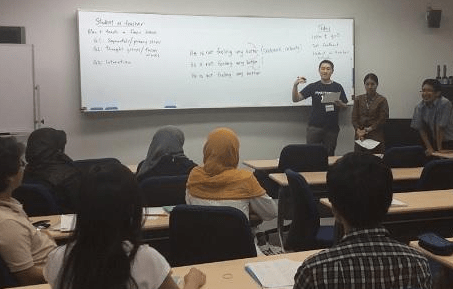by Paul McAleese
Have you ever let students be the teacher in class?
I have discovered that doing this can not only be really productive, but also very motivating for the students.
Teaching to improve your own ability
I remember doing judo back in my high school days and there was this one stronger student who used to win all the competitions. I noticed he always used to spend a lot of his time helping teach the newer students. This surprised me as I thought he would want to focus more on learning new things from the instructors. When I asked him why he did this, he said he found teaching others helpful as it continually forced him to review and refine his own knowledge.
Students as EFL teachers?
This got me thinking more about my EFL students and how asking them to teach might be motivational. Student as teacher type activities are not new in the EFL field and are often referred to using a range of terms with slightly varying meanings such as peer-teaching or partner learning (Kalkowski, 2001). Studies have shown such activities to be beneficial in a number of areas, from improving competence on the subject to building confidence and team-work/leadership skills (Mynard & Almarzouqi, 2006). Initially, I had a few concerns with the idea, such as students teaching other students incorrect content and how the less confident students would cope. Despite this, I reasoned that having students teach content that they had already been covered in class could be a great student-centered review activity.
The idea takes off
With this in mind, over the next few years I started experimenting with short activities where the students, in small groups, took turns teaching mini-lessons on parts of the course I had already covered. After some initial trial and error, I found the activities to be very productive and engaging for the students, and they seemed to really enjoy using content from previous classes to create and teach original lessons. So in this article, I thought I’d share some tips and ideas I have from my experiences using such activities in EFL classes.
Have students teach in small teams

I found that having the students prepare and teach their lessons in small groups of 3-4 students was most effective. Being in groups makes it less intimidating when they eventually have to teach their lessons in front of the class. Also, the small group size ensures all students have a chance to contribute. Having a mixture of student types in each group can also help (eg. high and low-ability), and sometimes it’s a good idea to assigning a more confident student the group leader.
Give specific topics and time-limits
It’s always better to give the groups different topics to prepare lessons on. This enables a range of content to be reviewed and also helps keep the other groups who are watching interested. Likewise, it’s a good idea to limit the actual lesson times to around 5min each, although the groups will need much longer to prepare (in my experience around 30min). To help the groups stream-line their lesson planning, try to be fairly specific with the topics assigned. For example, in a business communication class, some of the topics I use are ‘business introductions’, ‘taking telephone messages’, and ‘giving company tours’.
Preparation support
During the preparation time, I found it was best to give the groups as much creative freedom as possible while also being ready to give advice or help if needed. Just make sure all the students have some kind of involvement in the process and have a role to play in the lesson delivery. If some groups are having difficulty, they can be encouraged to review their textbooks, class notes, past test papers etc. for lesson content. Once groups have an idea of their content, encourage them to try and make their lessons engaging and interactive for the audience. Groups sometimes find this part challenging so it often helps to give them some ideas, for example, asking the audience what they know about a topic before giving them the answer. Other ideas could be using quiz-type games, spot-the-mistake activities, and short role plays or skits. Remind the groups that as teachers they can also use classroom facilities eg. whiteboard, marker pens, microphones, other props.
Give the students total control
Once the mini-lessons have started, it’s best to just take a seat at the back of the classroom and let the groups take control. Silently observe and try to save any content-related comments you have for the following feedback session. It’s also a good idea for the teacher to be a kind of chairperson who time-keeps and introduces each group as they come to the front of the class. To help create a fun atmosphere, I like to overdramatize things a bit here before each lesson starts, for instance, introducing the students with professor titles and prompting for applause and cheers. Having more confident groups teach first also helps set a good tone for later lessons. In my experience, the quality of the lessons will inevitably vary, but all the students usually get fully involved. It often results in a great atmosphere with laughter and friendly banter between the teaching group and the audience.
If necessary, redirect at the end
After all the lessons have finished, it’s always nice to congratulate all the groups on a great job and make a few positive comments about each lesson. Importantly, this is also the time when some redirection from the teacher may be needed if any of the lesson content was incorrect. Clearly, groups are going to make numerous mistakes in their lessons, especially with spelling etc. on the whiteboard. However, I found it is most effective to just focus on a few of the more important mistakes in their content. As with all teaching, rather than correcting these yourself, drawing attending to the mistakes and having the groups self-correct is always preferable.
Other ideas
While I like to limit this activity to a single lesson in a course, it could easily be expanded to a longer group projects. Extra time could be allocated over a number of classes for groups to create more comprehensive lesson plans and spend more time rehearsing in advance. Groups could even video their lessons and uploaded them to a shared site (or even YouTube) to be viewed and evaluated in a later class.
To sum up…
I’ve found such student as teacher activities to be very productive, easy to set up, and almost always result in a lot of fun with students. While there’s a limit to how often they can be used, they let students review lesson content in a creative way and also build their confidence and team-work skills. Some teachers may have concerns about letting students teach, but the lesson preparation can always be monitored and teacher redirections provided at the end.
I’m interested in other readers’ experiences with student as teacher activities. Do you often use them in your classes? What other variations have worked for you?
References
-
Kalkowski, P. (2001). Peer and cross-age tutoring. Northwest Regional Educational Laboratory School Improvement Research Series. Retrieved from <nwrel.org/scpd/sirs/9/c018.html
-
Mynard, J., & Almarzouqi, I. (2006). Investigating peer tutoring. ELT Journal, 60(1), 13-22.




